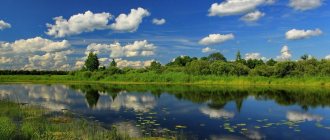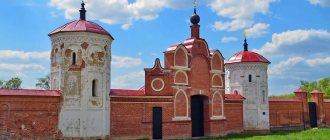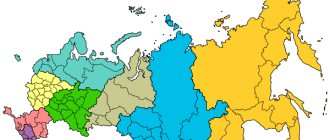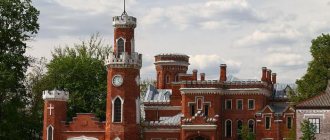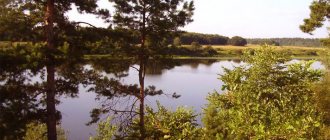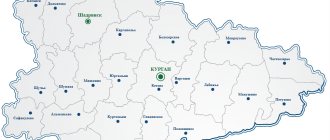The Ivanovo region is located in the Central Federal District. More than 1 million people live on the territory of this subject of the Russian Federation. On the map of the Ivanovo region from a satellite you can see roads and railways, cities and small settlements. The main water bodies in the region are the Klyazma and Volga rivers. During navigation, river transport docks in the following cities:
- Kineshma;
- Yuryevets;
- Puchezh;
- Zavolzhsky.
Using a map of the Ivanovo region with diagrams, you can find 1,700 rivers and 150 lakes. The largest water body in the region is the Gorky Reservoir.
The Ivanovo region ranks second to last among all regions of the country in terms of territory - it is only about 24 thousand km2. Most of the people inhabiting it live in cities and only a little more than 20% live in rural areas. As the map of the Ivanovo region by district shows, the territory of the region is limited from different sides by 4 regions:
- Kostroma;
- Yaroslavskaya;
- Nizhny Novgorod;
- Vladimirskaya.
To get a complete picture of the location of cities, rivers, and transport routes in the region, you can move around the map with the mouse, zooming in or out and moving in the desired direction. A convenient online service can become an indispensable assistant for travelers, motorists, guests and residents of the region.
Vologda region | Area 144 thousand sq. km
The Vologda region opens the top ten largest regions of the Russian Federation. It is located on an area of 144 thousand square meters. km, which in percentage terms is approximately 0.85% of the entire territory of the country. About 1.2 million people live here, and the population density is 8.22 people/sq. km. The subject was formed in 1937 by dividing the Northern region into Arkhangelsk and Vologda.
Murmansk region | Area 145 thousand square meters. km
The Murmansk region is in ninth place among the largest regions of the Russian state. It occupies an area of 145 thousand square meters. km. — 0.85% of the entire territory of the Russian Federation. The date of its formation is considered to be May 28, 1938. The territory of the subject is home to 762 thousand 173 people, which is a density of 5.26 people/sq. km. About 70% of the area is occupied by the Kola Peninsula. On the territory of the region there is the Baltic crystalline shield, which is a real mineralogical treasury, unparalleled in the world in terms of the diversity of minerals and minerals. Some of them are not found anywhere else.
Novosibirsk region | Area 177 thousand square meters. km
The Novosibirsk region ranks eighth among the largest regions of the Russian Federation. The area it occupies is 177 thousand square meters. km, which is 1.4% of the entire territory of Russia. The region is home to about 2.7 million people, and the population density is 15.54% people/sq. km. The bulk of the population is Russian (93%), about 7% are Germans, Ukrainians and Tatars. The subject was formed in 1937, when the West Siberian Territory was divided into the Altai Territory and the Novosibirsk Region. More than 500 deposits of various natural resources of the country are located here.
Science, education and culture
Largest scientific organizations:
As of 2007, there are 26 institutions of primary vocational education and 31 institutions of secondary vocational education operating in the region. In the general education system of the Ivanovo region there are 357 general education institutions, including: 6 lyceums, 7 gymnasiums, 41 schools with in-depth study of subjects. The total number of students in general education schools is 89,153 people, in evening schools - 2,089 students.
The number of university students per 10 thousand people in the region in 2006 was 482 people. Main professions in secondary vocational education institutions: medical workers, businessmen, lawyers, energy workers, car service workers, teachers, cultural workers. Training at universities is carried out in 125 specialties.
The leading higher education institutions in the region are:
Cultural organizations include: Ivanovo Regional Drama Theater, Ivanovo State Circus
The main professed religion is Orthodoxy. There are several Orthodox monasteries in the region: Resurrection-Fedorovsky in the Shuisky district, Nikolsky Monastery in Privolzhsk, Holy Dormition Monastery in Ivanovo, there are many churches with significant parishes.
Sverdlovsk region | Area 194 thousand sq. km
The Sverdlovsk region is one of the largest in Russia. Its lands are located on 194 thousand square meters. km, as a percentage of the country's area this is 1.14%. The subject is part of the Ural Federal District. Its foundation took place in 1732. The administrative center is the city of Yekaterinburg, which was previously called Sverdlovsk. More than 4 million people live here, which is 22.28 people/sq. km. This is one of the most densely populated regions of the state. On its territory there are deposits of gold, platinum, asbestos, bauxite, nickel, iron, manganese, chromium and copper. The largest chemical plant in the Russian Federation, Uralkhimplast, is located here.
Tomsk region | Area 314 thousand square meters. km
Among the largest regions of the Russian Federation, the Tomsk region ranks sixth. It accounts for 314 thousand square meters. km, which is 1.84% of the entire territory of the state. About 63% of the total area is occupied by taiga forests, and 29% is swamps. In terms of territory, the Tomsk region is slightly larger than Poland (310 thousand sq. km). The subject is part of the Siberian Federal District. The date of its formation is August 13, 1944. More than 1 million people live in the Tomsk region, which is a population density of 3.42 people/sq. km. As for natural resources, the territory is replete with them: there are about 100 oil fields, the largest reserves of coal, non-ferrous and ferrous metals, peat and natural gas.
Shuya has relatives in Valdai
As Kirill Baldin noted, “slightly less ancient than Plyos and Yuryevets are cities in the Ivanovo region, founded during the Mongol-Tatar yoke: Shuya, Lukh, Kineshma.” You can add Gavrilov Posad to this list.
A number of historians claim that Shuya was mentioned in Russian chronicles already in 1393–1394 as a significant settlement in the Nizhny Novgorod principality. Although as a settlement, without a doubt, it arose much earlier. Perhaps Shuya was one of the fortified cities built in the 13th century on the orders of Grand Duke Yuri Vsevolodovich before the invasion of Batu.
The city is named after the Shuya River, which flows into the Teza. Shuya has several namesakes. These are rivers in the basin of Lake Onega, the White Sea, tributaries of the Orsha and Unzha. That's why the city also has namesakes. For example, the village of Shuya, Valdai district, Novgorod region. The name may come from the Finnish word "suo" (swamp, lake, marshy area). According to another version, less probable, the name goes back to the ancient Slavic “oshyu”, that is, “on the left”, “on the left hand” (in this case, “on the left bank”).”
Our Shuya was first mentioned as a city in 1539, and before that time it was known as Borisoglebskaya Sloboda (after the church of the noble princes Boris and Gleb). In general, little is known about the history of Shuya before the beginning of the 17th century. Among the main reasons are the loss of ancient documents of the city during the Time of Troubles, as well as the lack of large-scale archaeological research.
Interesting facts about Shuya
The earliest mention of Shuya is associated with Prince Vasily Kirdyapa, to whom it was given by the Moscow Prince Vasily Dmitrievich. Kirdyapa's son, Yuri, became the founder of the famous family of princes Shuisky. Tsar Vasily Ivanovich Shuisky (reigned 1606–1610) belonged to this family.
Among the crowned persons, Ivan the Terrible (during his campaign against Kazan in 1549) and Peter I (in 1722 on his way to the Persian campaign) visited Shuya. In 1729, the daughter of Peter I, Princess Elizabeth, lived in Shuya, who loved to hunt in the surrounding forests. In 1837, while traveling around Russia accompanied by the famous Russian poet Vasily Zhukovsky, the future Emperor Alexander II visited Shuya.
Amur region | Area 362 thousand square meters. km
The Amur region is in fifth place among the largest regions of Russia. It occupies an area of 362 thousand square meters. km, which in percentage terms is equal to 2.12% of the entire area of the Russian Federation. The date of formation of the subject is considered to be October 20, 1932. For a long time it was part of the Khabarovsk Territory, but in 1948 it was separated into an independent region. In total, 805 thousand 689 people live in the region, and the population density is 2.23 people/sq. km. Currently, one of the world's largest gas processing plants is being built here, which will include the largest helium production complex. In addition, this region is rich in minerals and has huge reserves of timber.
Magadan region | Area 462 thousand sq. km
The Magadan region ranks fourth among the largest regions of Russia. An entity with a total area of 462 thousand square meters. km occupies 2.7% of the entire state. The founding date of the region is December 3, 1953. 146 thousand 345 people live on the territory of the subject, which is equal in density to 0.32 people/sq. km. The bulk of the population are Russians (72%) and Ukrainians (15%). The Magadan region completely belongs to the regions of the Far North, where permafrost reigns. On its territory there are large deposits of silver, gold, tin and tungsten. At the end of 2015, 979 tons of silver and 22 tons of gold were mined here.
Arkhangelsk region | Area 590 thousand sq. km
The Arkhangelsk region opens the top three regions of the Russian Federation in terms of area. The territory occupied by the subject is 590 thousand square meters. km, which is equal to 3.5% of the area of the entire country. According to this indicator, the region surpasses such states as Spain (504 thousand sq. km) and France (547 thousand sq. km). The formation of the subject occurred in 1937, when the Northern region of the RSFSR of the USSR was divided. About 1.2 million people live here, which is 1.22% people/sq. km. The largest deposits of gypsum, limestone and anhydride are concentrated in the region.
Area of territories of the Russian Federation by constituent entity (Table)
- Territory area of the Russian Federation by constituent entities of the Russian Federation as of January 1, 2022
- To find out the area of a subject of the Russian Federation in hectares (ha), you need to multiply the value in the table by 1000 (since the values are indicated in thousands of square kilometers) and then multiply by 100.
- 1 km2 = 100 ha
| The subject of the Russian Federation | Territory area, thousand square meters. km*) | Share of the subject’s territory in the total territory (%): | Rank of the subject's territory in relation to the territories: | ||
| Russia | federal district | all subjects of Russia | subjects included in the federal district | ||
| Russian Federation | 17125,2 | 100,0 | |||
| Central Federal District | 650,2 | 3,8 | 100,0 | 6 | |
| Belgorod region | 27,1 | 0,2 | 4,2 | 67 | 13 |
| Bryansk region | 34,9 | 0,2 | 5,4 | 62 | 8 |
| Vladimir region | 29,1 | 0,2 | 4,5 | 66 | 12 |
| Voronezh region | 52,2 | 0,3 | 8,0 | 51 | 3 |
| Ivanovo region | 21,4 | 0,1 | 3,3 | 74 | 17 |
| Kaluga region | 29,8 | 0,2 | 4,6 | 65 | 11 |
| Kostroma region | 60,2 | 0,4 | 9,3 | 47 | 2 |
| Kursk region | 30,0 | 0,2 | 4,6 | 64 | 10 |
| Lipetsk region | 24,0 | 0,1 | 3,7 | 72 | 16 |
| Moscow region | 44,3 | 0,3 | 6,8 | 55 | 5 |
| Oryol Region | 24,7 | 0,1 | 3,8 | 71 | 15 |
| Ryazan Oblast | 39,6 | 0,2 | 6,1 | 58 | 6 |
| Smolensk region | 49,8 | 0,3 | 7,7 | 53 | 4 |
| Tambov Region | 34,5 | 0,2 | 5,3 | 63 | 9 |
| Tver region | 84,2 | 0,5 | 12,9 | 38 | 1 |
| Tula region | 25,7 | 0,1 | 3,9 | 70 | 14 |
| Yaroslavl region | 36,2 | 0,2 | 5,6 | 61 | 7 |
| Moscow | 2,6 | 0,01 | 0,4 | 83 | 18 |
| Northwestern Federal District | 1687,0 | 9,9 | 100,0 | 4 | |
| Republic of Karelia | 180,5 | 1,1 | 10,7 | 17 | 3 |
| Komi Republic | 416,8 | 2,4 | 24,7 | 11 | 1 |
| Arkhangelsk region including Nenets Autonomous Okrug | 589,9 | 3,4 | 35,0 | ||
| Nenets Autonomous Okrug | 176,8 | 1,0 | 10,5 | 19 | 4 |
| Arkhangelsk region without Nenets Autonomous Okrug | 413,1 | 2,4 | 24,5 | 12 | 2 |
| Vologda Region | 144,5 | 0,8 | 8,6 | 26 | 6 |
| Kaliningrad region | 15,1 | 0,1 | 0,9 | 77 | 10 |
| Leningrad region | 83,9 | 0,5 | 5,0 | 39 | 7 |
| Murmansk region | 144,9 | 0,8 | 8,6 | 25 | 5 |
| Novgorod region | 54,5 | 0,3 | 3,2 | 49 | 9 |
| Pskov region | 55,4 | 0,3 | 3,3 | 48 | 8 |
| Saint Petersburg | 1,4 | 0,01 | 0,1 | 84 | 11 |
| Southern Federal District | 447,8 | 2,6 | 100,0 | 7 | |
| Republic of Adygea | 7,8 | 0,05 | 1,7 | 81 | 7 |
| Republic of Kalmykia | 74,7 | 0,4 | 16,7 | 42 | 4 |
| Republic of Crimea | 26,1 | 0,2 | 5,8 | 69 | 6 |
| Krasnodar region | 75,5 | 0,4 | 16,9 | 41 | 3 |
| Astrakhan region | 49,0 | 0,3 | 10,9 | 54 | 5 |
| Volgograd region | 112,9 | 0,7 | 25,2 | 31 | 1 |
| Rostov region | 101,0 | 0,6 | 22,5 | 33 | 2 |
| Sevastopol | 0,9 | 0,005 | 0,2 | 85 | 8 |
| North Caucasus Federal District | 170,4 | 1,0 | 100,0 | 8 | |
| The Republic of Dagestan | 50,3 | 0,3 | 29,5 | 52 | 2 |
| The Republic of Ingushetia | 3,6 | 0,02 | 2,1 | 82 | 7 |
| Kabardino-Balkarian Republic | 12,5 | 0,1 | 7,3 | 79 | 5 |
| Karachay-Cherkess Republic | 14,3 | 0,1 | 8,4 | 78 | 4 |
| Republic of North Ossetia-Alania | 8,0 | 0,05 | 4,7 | 80 | 6 |
| Chechen Republic | 15,6 | 0,1 | 9,2 | 76 | 3 |
| Stavropol region | 66,2 | 0,4 | 38,8 | 45 | 1 |
| Volga Federal District | 1037,0 | 6,1 | 100,0 | 5 | |
| Republic of Bashkortostan | 142,9 | 0,8 | 13,8 | 27 | 2 |
| Mari El Republic | 23,4 | 0,1 | 2,3 | 73 | 13 |
| The Republic of Mordovia | 26,1 | 0,2 | 2,5 | 68 | 12 |
| Republic of Tatarstan | 67,8 | 0,4 | 6,5 | 44 | 7 |
| Udmurt republic | 42,1 | 0,2 | 4,1 | 57 | 10 |
| Chuvash Republic | 18,3 | 0,1 | 1,8 | 75 | 14 |
| Perm region | 160,2 | 0,9 | 15,5 | 23 | 1 |
| Kirov region | 120,4 | 0,7 | 11,6 | 30 | 4 |
| Nizhny Novgorod Region | 76,6 | 0,4 | 7,4 | 40 | 6 |
| Orenburg region | 123,7 | 0,7 | 11,9 | 29 | 3 |
| Penza region | 43,4 | 0,3 | 4,2 | 56 | 9 |
| Samara Region | 53,6 | 0,3 | 5,2 | 50 | 8 |
| Saratov region | 101,2 | 0,6 | 9,8 | 32 | 5 |
| Ulyanovsk region | 37,2 | 0,2 | 3,6 | 59 | 11 |
| Ural federal district | 1818,5 | 10,6 | 100,0 | 3 | |
| Kurgan region | 71,5 | 0,4 | 3,9 | 43 | 6 |
| Sverdlovsk region | 194,3 | 1,1 | 10,7 | 16 | 3 |
| Tyumen region including autonomous okrugs | 1464,2 | 8,5 | 80,5 | ||
| Khanty-Mansiysk Autonomous Okrug | 534,8 | 3,1 | 29,4 | 7 | 2 |
| Yamalo-Nenets Autonomous Okrug | 769,3 | 4,5 | 42,3 | 5 | 1 |
| Tyumen region without autonomous okrugs | 160,1 | 0,9 | 8,8 | 24 | 4 |
| Chelyabinsk region | 88,5 | 0,5 | 4,9 | 36 | 5 |
| Siberian Federal District | 5145,0 | 30,0 | 100,0 | 2 | |
| Altai Republic | 92,9 | 0,5 | 1,8 | 35 | 11 |
| The Republic of Buryatia | 351,3 | 2,1 | 6,8 | 14 | 4 |
| Tyva Republic | 168,6 | 1,0 | 3,3 | 20 | 7 |
| The Republic of Khakassia | 61,6 | 0,4 | 1,2 | 46 | 12 |
| Altai region | 168,0 | 1,0 | 3,3 | 21 | 8 |
| Transbaikal region | 431,9 | 2,5 | 8,4 | 10 | 3 |
| Krasnoyarsk region | 2366,8 | 13,8 | 46,0 | 2 | 1 |
| Irkutsk region | 774,8 | 4,5 | 15,1 | 4 | 2 |
| Kemerovo region | 95,7 | 0,6 | 1,9 | 34 | 10 |
| Novosibirsk region | 177,8 | 1,0 | 3,5 | 18 | 6 |
| Omsk region | 141,1 | 0,8 | 2,7 | 28 | 9 |
| Tomsk region | 314,4 | 1,8 | 6,1 | 15 | 5 |
| Far Eastern Federal District | 6169,3 | 36,0 | 100,0 | 1 | |
| The Republic of Sakha (Yakutia) | 3083,5 | 18,0 | 50,0 | 1 | 1 |
| Kamchatka Krai | 464,3 | 2,7 | 7,5 | 8 | 4 |
| Primorsky Krai | 164,7 | 1,0 | 2,7 | 22 | 7 |
| Khabarovsk region | 787,6 | 4,6 | 12,8 | 3 | 2 |
| Amur region | 361,9 | 2,1 | 5,9 | 13 | 6 |
| Magadan Region | 462,5 | 2,7 | 7,5 | 9 | 5 |
| Sakhalin region | 87,1 | 0,5 | 1,4 | 37 | 8 |
| Jewish Autonomous Region | 36,3 | 0,2 | 0,6 | 60 | 9 |
| Chukotka Autonomous Okrug | 721,5 | 4,2 | 11,7 | 6 | 3 |
- *) The sum of the area of the territories of the Russian Federation for the constituent entities of the Russian Federation that are part of the federal district may not coincide with the data for the federal district due to rounding.
- _______________
- Source of information: Rosstat (gks.ru)
Source: https://infotables.ru/strany-i-goroda/909-ploshchad-territorij-rf
Irkutsk region | Area 774 thousand sq. km
The Irkutsk region ranks second among the largest regions of Russia. The total territory occupied by the subject is approximately 774 thousand square meters. km, which is almost 5% of the entire area of the state. In terms of territory, it is almost equal to Turkey, whose area is 780 thousand square meters. km. The founding date of the region is considered to be September 26, 1937, when the East Siberian region of the RSFSR was divided into Irkutsk and Chita. As of 2016, about 2.5 million people live here, which in terms of density is 3.11 people/sq. km. The Irkutsk region is one of the main suppliers of petroleum products, timber, coal and aluminum.
From Chuvil to Plyos
As Kirill Baldin, head of the Department of Russian History at Ivanovo State University, told us, the most ancient cities of the Ivanovo region are Plyos and Yuryevets. Interestingly, both toponyms are clearly Slavic in origin.
For a long time, the official founding date of Plyos (Volga region) was considered to be 1410, when, according to chronicles, “Great Prince Vasily Dmitrievich ordered the destruction of the city of Pleso.” The word “reach” itself in ancient times meant “lake” or “a stretch of river from turn to turn.”
But there is an opinion that this prince, the son of Dmitry Donskoy, only ordered the city to be rebuilt. The location is convenient: firstly, the Volga does not meander in this area, providing a wide overview of the surrounding area; secondly, in its bed there was a stone labyrinth from the Vinnaya and Kosaya ridges, impeding the unhindered passage of ships. And local pilots showed the way only after presenting a permit or paying a fee.
The director of the Plyos Museum of the Old Russian Family, Pavel Travkin, believes that Plyos is much older: it was founded in the 12th century by Yuri Dolgoruky, like Moscow. The candidate of historical sciences also says (not all of his colleagues agree with this opinion) that long before the Slavic city, from the 4th century BC. e. The role of the unifying center of the district was played by the legendary city of Chuvil, a fortress in the town of Alabuga, 12 kilometers downstream of the Volga. Its founders were Volga Finns, the ancestors of the Merians. The legendary Chuvil, believes Pavel Travkin, existed until the 12th century, passing the baton to the northern outpost of Rostov-Suzdal Rus'. Then, just as Grand Duke Yuri founded Moscow on the southern outskirts of his possessions, he cut down the Plyos fortress on the northern border. Mention of the city was found in the Novgorod Chronicle for 1141. The antiquity of Plyos is also confirmed by archaeological research materials.
After the Horde devastation of 1238, Plyos quickly recovered, and at the end of the 14th century it appeared in the “list of Russian cities far and near” (the name accepted in historical science for a special article-appendix of a geographical nature, placed in Russian chronicles and handwritten collections). But Travkin also agrees that Plyos’s “finest hour” came in 1410, when a new powerful fortress was built here, built using the latest military technology of that time.
Interesting facts about Plyos
The Tver merchant Afanasy Nikitin in his famous “Walking across Three Seas” mentioned how he was allowed through the Plyos customs without any hindrance. The city also participated in the development of the Urals and the Urals: expeditionary military detachments were formed here. And in 1612, Plyos received the militia of Prince Dmitry Pozharsky, which liberated Moscow from the Polish-Lithuanian invaders.
Tyumen region | Area 1,464 thousand sq. km
Tyumen region is the largest region in Russia. The area of the subject is 1464 thousand square meters. km, which is equal to 9% of the entire territory of the Russian Federation. If we unite Germany, Italy, France and Great Britain, then the territory they occupy will be exactly equal to the Tyumen region. Its foundation took place in 1944 by separating some areas of the Kurgan and Omsk regions. The population as of 2016 is 3,615,485 people, density is 2.47 people/sq. km. Approximately 90% of the districts belong to the Far North. It is here that the main deposits of such minerals and natural resources as gas and oil are concentrated.
116 24
Map of Ivanovo region with cities and villages
Moving around the map of the Ivanovo region with cities and villages, you can not only see the location of settlements, but also see their streets, houses and attractions. The most famous cities in the region through which the Golden Ring tourist route passes are Ivanovo, Plekh and Ples. But the most attractive is the city of Yuryevets and its main attractions:
- A. Tarkovsky Museum;
- five-tier bell tower;
- Mount Asaph.
The location of the city on the banks of a beautiful reservoir attracts not only lovers of historical monuments and connoisseurs of ancient Russian crafts, but also numerous fishermen who come here in whole companies.
Using a map of the Ivanovo region with villages, you can find another amazing settlement - the village of Kholui. Before the revolution, it was the center of icon painting in Russia. Icons painted in this village are exhibited in the most famous churches in the country. Currently, souvenir lacquer miniatures are made here, which tourists are happy to purchase.

